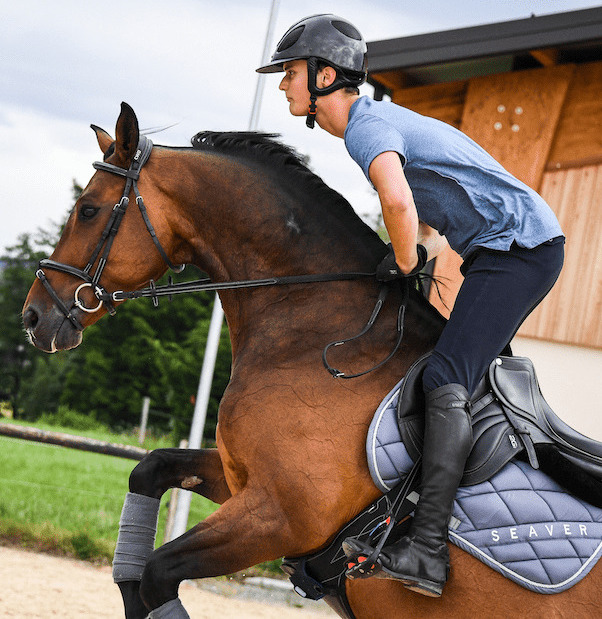-15 % sur votre première commande
rentrez votre email pour recevoir le code


Le paiement x10 disponible sur la boutique ! Commandez votre airbag SAFEFIT pour 50€/mois
mercredi, 4 janvier, 2017
What is movement symmetry, why is it important and what are the influencing factors?
Movement symmetry corresponds to an equal use of both forelimbs and both hind limbs. This means the footfall timing, stance duration, swing duration and sweep angle of the right forelimb are identical to that of the left forelimb. It is the same for the hind limbs. « Movement symmetry is an absolute prerequisite for horse training. It is also a main component of the performance assessment of dressage judges, who grade gaits by evaluating their correctness, purity and regularity. »
A sound horse moving on a straight line on a flat surface should have symmetrical movements. In order to measure this, Seaver compares the up-and-down as well as lateral (left-to-right) movements of the horse’s chest when each limb touches the ground (figure 1). These movements will be symmetrical for each limb in a sound horse. « During international shows, in case asymmetry is found during the horse inspection, the rider will presumably be forced to retire. If not, the horse will be penalized in his extensions where the weakness will likely be emphasized. Movements revealing an asymmetry will not be given a satisfactory score. »
However, it is clear that this rule only applies to symmetrical gaits, such as the walk, trot, and amble or pace. Canter and gallop, being asymmetrical gaits, the footfall of the left forelimb will always be different from that of the right forelimb. (1) « An asymmetrical horse may be limited in many aspects of his learning process, and will necessarily be less competitive. Each exercise asked of the horse might be affected by this issue. Although, movements at the walk and trot will be the most impacted, it could also show when the horse is cantering. For instance, the flying change from the left to the right lead will be different from that to the left lead regarding amplitude and/or straightness if the horse is asymmetrical. »

If a horse moves symmetrically, he will bear the same weight on his left and right forelimb, and the same goes for the hind limbs. Most lameness will cause pain at footfall so when a horse is lame, he will bear less weight on the affected limb to relieve the pain. (2) « As a rider or trainer, it is essential to be cautious about the smallest asymmetry and rapidly consult a specialist. Prevention is necessary to ensure no health issue will endanger your horse’s health and wellbeing. We must be able to detect the slightest anomaly, rapidly locate its cause, and take appropriate measures. In our jargon, we might say that a horse is falling to the left; meaning that the pain is on the right side. Before questioning our riding skills, and observing the issue from a purely technical point of view, we must check that our horse is sound. »
A threshold of about 25% movement asymmetry is suggested to detect an issue. This means that a horse putting 25% weight less weight on one limb compared to the corresponding other could have a problem and will need to see a vet. Seaver measures weight distribution per limb to help you detect an issue in early stages. « The later a veterinary problem is taken care of, the higher the risk of complications. It is easy not to notice an asymmetry, overlook it or misinterpret it. Being able to rely on a detailed analysis of symmetry reduces uncertainty and maximizes our chances of keeping our horse sound and healthy. »
Figure 2 below is an example of a horse putting more weight on the right forelimb, indicating left forelimb lameness.
 Figure 2
Figure 2
Besides lameness, there are other factors that can impact movement symmetry. There are significant differences in symmetry measures when straight-line movements are compared to movements in a circle. When working in a circle, horses naturally lean the inside, with an angle of up to 20° compared to a straight position. Naturally, this means the horse’s weight will move towards the inside limbs. The angle of inclination will vary depending on the diameter of the circle, and speed of the horse. Seaver can measure all these parameters, enabling a comparison of data between different exercises and direction. The inclination angle of the horse’s body can also be used as indicator of orthopedic problems when the speed and diameters remain constant. Indeed, a horse with a painful inside limb will tend to lean less towards the inside to reduce the load on this limb.
Another factor that can influence movement symmetry is the rider’s balance. If the rider does not seat tall and straight on the saddle, it will cause the horse to loose balance and his movements to be asymmetrical.
Finally, the ground has to be considered. In order to best assess movement symmetry, the horse must be on a regular and flat ground.
Valérie De Clerck
Doctor of Veterinary Medicine
*We also want to give a warm thanks to Camille, dressage rider, for her participation to the writing of this article 🙂